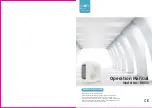
35
3
JOHNSON CONTROLS
FORM 145.05-NOM1 (708)
To protect warranty, this equipment
must be installed and serviced by an
authorized Johnson Controls service
mechanic or a qualified service person
experienced in air handling and con-
denser unit installation. Installation
must comply with all applicable codes,
particularly in regard to electrical
wiring and other safety elements such
as relief valves, HP cut-out settings,
design working pressures and venti-
lation requirements consistent with
the amount and type of refrigerant
charge.
Lethal voltages exist within the control
panel. Before servicing, open and tag
all disconnect switches.
CRANKCASE HEATERS
In order to energize the crankcase heaters prior to
startup, line voltage must be supplied to the unit and
circuit breakers; CBCHA for compressor system
A, CBCHB for compressor system B, CBCHC for
compressor system C, and CBCHD for compressor
system D must be turned on.
The heater is interlocked with the compressor contactor
and is not controlled directly by the microprocessor.
When the compressor is off, a normally closed auxiliary
contact on the compressor contactor closes the circuit
and applies power to the crankcase heater.
The purpose of the crankcase heater is to prevent
the migration of refrigerant to the crankcase during
shutdown, assuring proper lubrication of the compressor
on start-up.
Anytime power is removed from the unit for more than
an hour, the crankcase heater should be left on for 24
hours prior to start.
Power must be applied to the unit
24 hours prior to starting the unit
compressors. Failure to observe this
requirement can lead to compressor
damage and voiding of the compressor
warranty.
PRE-STARTUP REQUIREMENTS
1. Inspect the unit for shipping or installation dam-
age.
2. Verify the unit is completely and properly installed
with ductwork connected. Verify that all construc-
tion debris is removed and filters are clean.
3. With all electrical disconnects open, check all
electrical connections to be sure they are tight.
4. Visually check for refrigerant piping leaks.
5. The compressor oil level should be maintained so
that an oil level is visible in the sight glass. The
oil level can only be tested when the compressor
is running in stabilized conditions, guaranteeing
there is no liquid refrigerant in the lower shell of
the compressor. With the compressor running the
oil should be between ¼ and ¾ in the sight glass.
At shutdown, the oil level can fall to the bottom
limit of the oil sight glass.
6. Check the control panel to assure it is free of for-
eign material (wires, metal chips, etc).
7. Visually inspect field wiring (power and control).
Wiring must meet NEC and local codes.
8. Verify fuse sizing in main circuits.
9. On VAV and FlexSys units verify the pneumatic
tubing has been field installed between the pres-
sure transducer in the unit and the probe(s) in the
ductwork or underfloor space.
10. Check the tightness of setscrews in bearings,
drives, and fan wheels
(see Table 10).
SETSCREW DIAMETER
TORQUE MIN.
(FT.- LBS)
#10
4.3
1/4”
10.0
5/16”
20.0
3/8”
25.0
TABLE 10 – SETSCREW TORQUES
SECTION 3 – START-UP
Summary of Contents for York VERSECON YSWD 012
Page 12: ...12 JOHNSON CONTROLS FORM 145 05 NOM1 708 THIS PAGE INTENTIONALLY LEFT BLANK ...
Page 58: ...58 JOHNSON CONTROLS FORM 145 05 NOM1 708 THIS PAGE INTENTIONALLY LEFT BLANK ...
Page 106: ...106 JOHNSON CONTROLS FORM 145 05 NOM1 708 THIS PAGE INTENTIONALLY LEFT BLANK ...
Page 112: ...112 JOHNSON CONTROLS FORM 145 05 NOM1 708 THIS PAGE INTENTIONALLY LEFT BLANK ...
















































